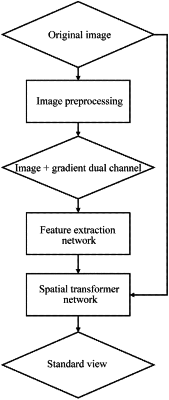| CPC G06T 3/60 (2013.01) [G06N 3/045 (2023.01); G06T 11/006 (2013.01); G06T 2207/20084 (2013.01); G06T 2210/41 (2013.01)] | 7 Claims |

|
1. An automatic turning method from an SPECT three-dimensional reconstructed image to a standard view, wherein the SPECT three-dimensional reconstructed image to be orientated is taken as an input, the standard view is obtained by using an automatic reorientation model of the SPECT three-dimensional reconstructed image for automatic reorientation ; wherein the automatic reorientation model of the SPECT three-dimensional reconstructed image comprises a feature extraction network and a spatial transformer network composed of a convolution module and a fully connected layer, and training of the SPECT three-dimensional reconstructed image automatic reorientation model comprises the following steps:
step 1, acquiring a SPECT three-dimensional reconstructed image A and a corresponding standard SPECT image S for clinical analysis after reorientation , and extracting a rigid registration parameter P between the SPECT three-dimensional reconstructed image A and the standard SPECT image S to form a mapping database of the SPECT three-dimensional reconstructed image A, the rigid registration parameter P and the standard SPECT image S, wherein the rigid registration parameter P comprises translation parameters in three directions and rotation angle parameters in three angles;
step 2, inputting the SPECT three-dimensional reconstructed image A into the feature extraction network, using the convolution module to extract features of the SPECT three-dimensional reconstructed image A, and converting the features into a 6-dimensional feature vector T through full connection;
step 3, applying the feature vector T to the SPECT three-dimensional reconstructed image A by using the spatial transformer network to obtain a predicted image B; and
step 4, constructing an image loss function L-img between the predicted image B and the standard SPECT image S and a parameter loss function L-par between the feature vector T and the rigid registration parameter P, and training and optimizing the network to obtain the best and most robust automatic reorientation model of the SPECT three-dimensional reconstructed image;
wherein the input of the feature extraction network further comprises a gradient map of an input image; and
wherein in the step 4, the image loss function L-img and the parameter loss function L-par are combined to construct an overall joint loss function L:L=δL-par+L-img, where δ is a weight coefficient with a value of 0.3.
|